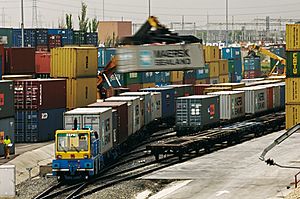Coslada Dry Port facts for kids
The Dry Port of Madrid, also known as the Dry Port of Coslada, is a very important place for moving goods around Spain. It's located in a town called Coslada, which is close to Madrid. Think of it like a giant sorting center for products that travel by sea or train. Instead of being right next to the ocean, it's inland, connecting big seaports to the heart of Spain.
Contents
What is a Dry Port?
A dry port is a special kind of logistics center. It acts like an extension of a seaport, but it's built far away from the coast. Goods that arrive on big ships at coastal ports are loaded onto trains or trucks. These trains or trucks then bring the goods to the dry port. Here, the goods are stored, sorted, and prepared for their final journey to shops or factories. It helps make trade faster and more efficient.
History of the Madrid Dry Port
The idea for the Dry Port of Madrid started a long time ago, in 1995. It took a few years to plan and build. The port officially began its operations in 2001. Its main goal was to connect the center of Spain with some of the country's biggest seaports. These include the Port of Algeciras, the Port of Valencia, the Port of Bilbao, and the Port of Barcelona.
How the Port Grew
Over time, the connection with the Port of Valencia became super important. By 2016, a huge amount of the goods coming through the Dry Port of Coslada – about 92% – were linked to the Port of Valencia. This shows how crucial that link became for moving products across Spain.
Who Manages the Port?
Originally, the port was managed by a company called Noatum. However, a big change happened when a Chinese company, COSCO Shipping Ports, bought shares of Noatum. Because of this, the management of the terminal, which is called Conte Rail, came under the control of Cosco. This means a global company now helps manage this important Spanish logistics hub.
Customs Services at the Port
The Dry Port of Madrid also has its own special customs service. This is very important for goods coming from other countries. Customs officers check the goods and make sure all the right taxes and rules are followed. Having this service directly at the dry port makes it easier and quicker to get imported goods into Spain.
See also
- For more information in Spanish, especially for kids, check out: Puerto seco de Coslada para niños



